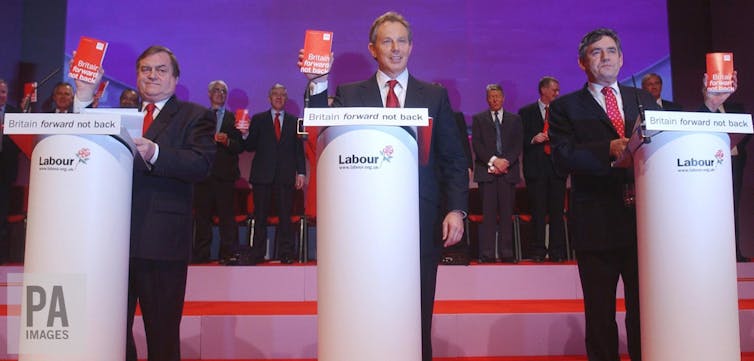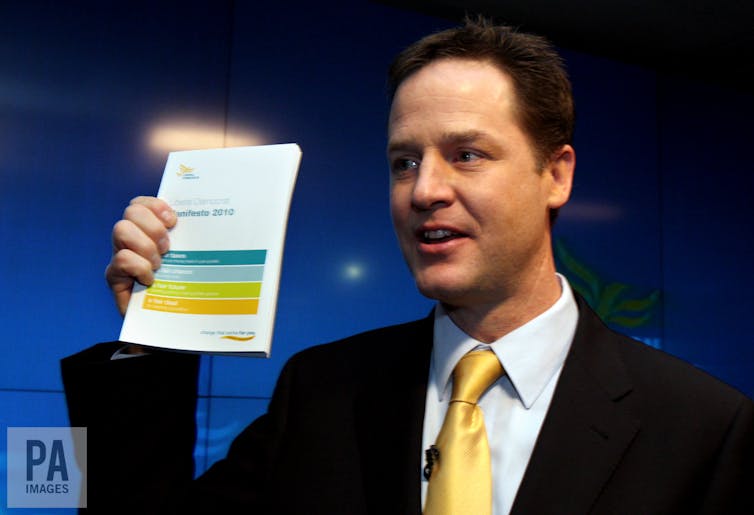The launch of a party’s manifesto is among the most decisive moments in a British general election campaign. Manifestos are not merely devices to harvest votes at election time. They establish the agenda for government that the party will pursue in office.
Manifestos have a quasi-constitutional authority in the British political system. If a party has secured a parliamentary majority in the House of Commons on the basis of its manifesto, the Salisbury Convention states that the government’s programme cannot be vetoed by a recalcitrant House of Lords.
Political parties approach manifesto writing very differently. The Labour party has a process that ensures all of the key elements on the National Executive Committee (NEC) have influence. So the Parliamentary Labour Party (PLP), the trade unions, constituency Labour parties and affiliated societies all take part in drawing the document up. Clause five of Labour’s constitution requires the manifesto to be formally agreed by the party’s stakeholders at a special meeting of the NEC.
This rule was designed in the 1970s and 1980s to address the difficulties encountered by Harold Wilson’s governments in their relations with the party. At the time there was a suspicion on the left that the leadership would betray the party’s grassroots by refusing to implement the radical measures contained in the Labour manifesto.

The Conservatives have traditionally been more pragmatic and flexible, giving control of their manifesto almost entirely to the leader and the central party organisation.
What’s the point of a manifesto?
Manifestos have had distinct purposes at various historical moments in British political history. Labour’s 1945 and 1979 manifestos were relatively short and pithy documents. They set out at a broad vision of society that was a decisive break from what had gone before. In contrast, Tony Blair’s manifesto in 2001 and 2005 spelled out his approach to public service reform across health, education and criminal justice, providing a mass of technocratic detail. Similarly, in 2010 David Cameron set out his comprehensive plan for the Big Society.

Manifestos also matter because they can create damaging hostages to fortune. Labour’s manifesto in 1983 was described as “the longest suicide note in history” because it featured electorally unpopular commitments to public ownership, state planning and unilateral nuclear disarmament.
The Conservatives’ 1987 manifesto proposed reforming the domestic rates system and a “community charge”, subsequently known as the Poll Tax. The unpopularity of the Poll Tax led to the downfall of Margaret Thatcher in 1990.
In the 2010 election, the Liberal Democrats famously made a commitment to scrap university tuition fees – a pledge that was dropped once the party entered a coalition government with the Conservatives. The Liberal Democrats were accused of egregious political betrayal and suffered dreadful losses in the next election as a result.
Reading between the lines
In the 2017 election, the Conservative manifesto will be more heavily scrutinised than the Labour or Liberal Democrat manifestos, since the Conservatives are expected to win a parliamentary majority on the basis of the published polls. But, at the same time, the confidence with which the governing party has entered this race means it may not feel the need to make costly pre-election commitments in its manifesto. The leak of Labour’s draft manifesto indicates the party is still plagued by internal divisions as to its long-term direction.
What is less clear about party manifestos is how far they actually assist the democratic process. Very few people will read the manifesto of the party they are voting for. Most people depend on soundbite summaries that appear in the mass media.
Manifestos are unlikely to disappear from party’s campaigns, but there should be more independent scrutiny of manifestos: arm’s-length bodies that are formally independent of government such as the Office for Budgetary Responsibility or the Institute for Fiscal Studies should be tasked with producing detailed costings and assessments of each party’s manifesto to assist public debate. That might help voters digest the information they need before voting and help them make informed choices.

